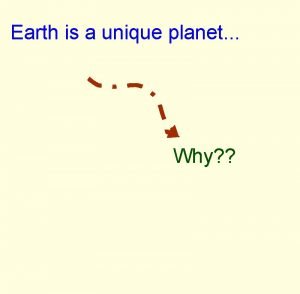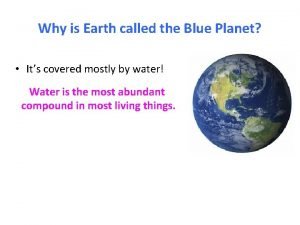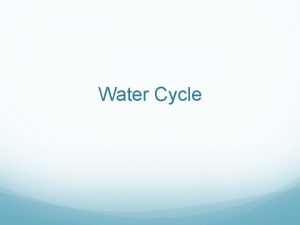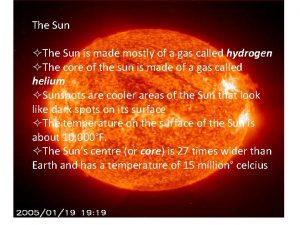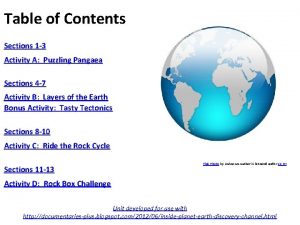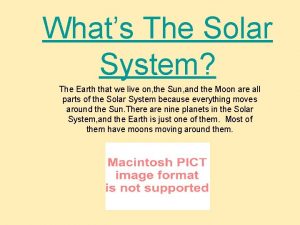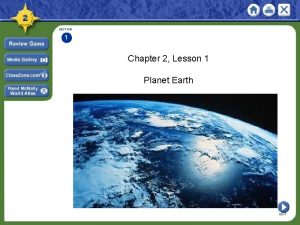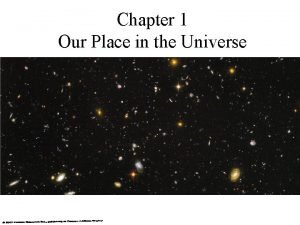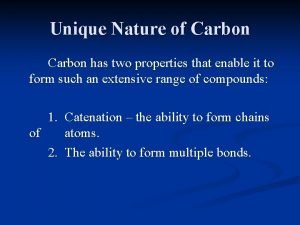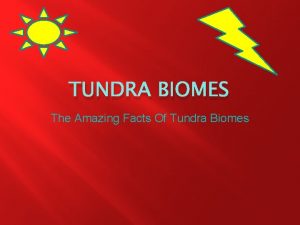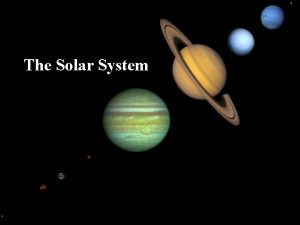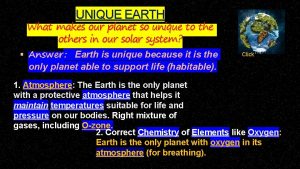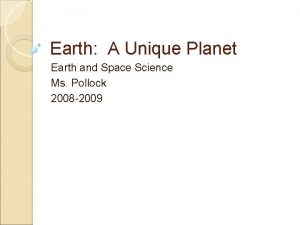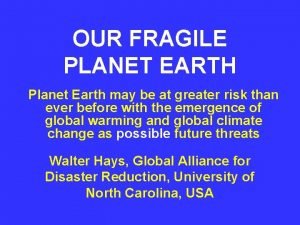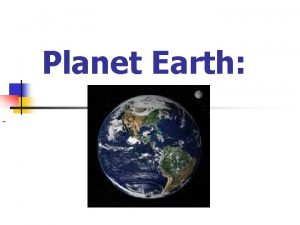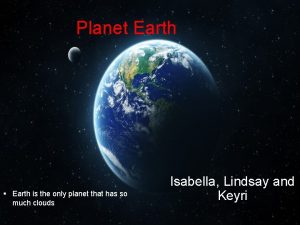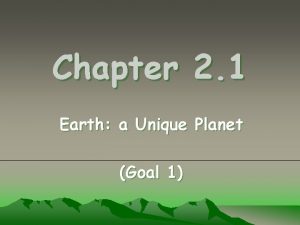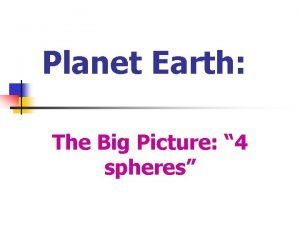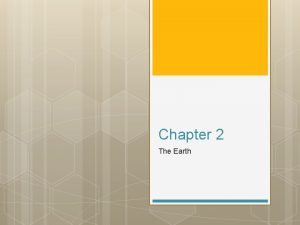2 1 Earth A Unique Planet Chapter 2





















- Slides: 21

2. 1 Earth: A Unique Planet Chapter 2: Ea rth as a Syste m Austin High S chool 20152016 Earth and Sp ace

Earth is Unique for Several Reasons 0 Only know planet that has water on it surface 0 Atmosphere contains large proportion of oxygen 0 Know to support life

Earth Basics 0 0 0 0 3 rd planet from the sun Formed 4. 6 billion years ago Made mostly of rock 70% surface covered by the thin layer of water called global ocean Earth is oblate spheroid- slightly flattened sphere Spinning of earth on its axis makes the polar region flatten and the equatorial zone bulge. Earth pole to pole circumference- 40, 007 km Earth equatorial circumference- 40, 074 km

Earth Basics 0 Earth surface relatively smooth 0 Distance between high points and low points are small relative to earth’s size 0 Height of tallest mountain and the depth of deepest ocean trench is about 20 km 0 Small compares to earth’s average diameter of 12, 756 km.

Earth’s Interior 0 Direct observation of earth’s interior is limited to upper few kilometers reached by drilling 0 We rely on indirect methods to study earth’s greater depths 0 Ex. Through studies of seismic waves, and the way they travel through the earth, we have learned it is made up of: 0 3 major compositional zones (crust/mantle/core) 0 5 major structural zones (lithosphere/asthenosphere/mesosphere/outercore/inner-core)

Composition Zones of Earth’s Interior Crust 0 The thin, outermost zone of earth’s is called the crust 0 Crust makes up 1% of earth’s mass 0 Crust beneath the oceans is called oceanic crust (5 -10 km thick) 0 Crust that makes up the continents is called continental crust (15 -70 km thick) 0 Continental crust is thickest beneath high mountain ranges. 0 The crust of the Earth is broken into many pieces called plates.

Composition Zones of Earth’s Interior Mantle 0 The mantle, layer that underlies the crust 0 Mantle is denser than the crust, its nearly 2, 900 km thick and makes up 2/3 of the earth’s mass.

Composition Zones of Earth’s Interior Core 0 Center of earth is a sphere, radius is about 3, 500 km, called the core 0 Mainly composed iron and nickel

The 3 compositional zones of earth’s interior are divided into five structural zones.

Structural Zones of Earth’s Interior Lithosphere 0 Lithosphere is the solid, outer layer of earth that consists of the crust and the rigid upper part of the mantle 0 Uppermost part of the mantle is cool and brittle 0 Rigid layer is 15 to 300 km thick

The Lithospheric Plates The crust of the Earth is broken into many pieces called plates. The plates "float" on the soft, semi-rigid asthenosphere.

Structural Zones of Earth’s Interior asthenosphere 0 The solid, plastic layer of the mental beneath the lithosphere 0 Made of mantle rock that flows very slowly 0 Allows tectonic plates to move on top of it 0 200 km thick

Convection Currents The middle mantle "flows" because of convection currents. Convection currents are caused by the very hot material at the deepest part of the mantle rising, then cooling and sinking again --repeating this cycle over and over.

Structural Zones of Earth’s Interior mesosphere 0 Literally the “middle sphere” the strong lower part of the mantle between asthenosphere and outer core 0 Pressure is so large that it is solid, its rigid 0 The lower mantle, ends at 2900 km deep

Structural Zones of Earth’s Interior Outer Core 0 At the depth of about 2900 km lies the boundary between mantle and the outer core 0 Outer core is a dense liquid 0 The core of the Earth is like a ball of very hot metals. 0 The outer core is made up of iron and is very dense.

Structural Zones of Earth’s Interior Inner Core 0 Inner core begins at a depth of 5150 km 0 Inner core is dense, rigid solid 0 The inner core of the Earth has temperatures and pressures so great the metals are squeezed together and are not able to move.

Earths Interior Part 2 0 To learn about Earth's interior, scientists use energy to “see” the different layers of the Earth, just like doctors can use an MRI, CT scan, or x-ray to see inside our bodies.

0 by looking at how energy travels from the point of an earthquake. These are seismic waves (Figurebelow). Seismic waves travel outward in all directions from where the ground breaks at an earthquake. 0 Two types of seismic waves are most useful for learning about Earth’s interior.

P waves 0 P-waves (primary waves) are fastest, traveling at about 6 to 7 kilometers (about 4 miles) per second, so they arrive first at the seismometer. 0 Seismic waves move faster through denser or more rigid material. As P-waves encounter the liquid outer core, which is less rigid than the mantle, they slow down. This makes the P-waves arrive later and further away than would be expected. The result is a P-wave shadow zone.

S waves 0 S-waves (secondary waves) are about half as fast as P -waves, traveling at about 3. 5 km (2 miles) per second, and arrive second at seismographs. S-waves move in an up and down motion perpendicular to the direction of wave travel. 0 This produces a change in shape for the earth materials they move through. Only solids resist a change in shape, so S-waves are only able to propagate through solids. S-waves cannot travel through liquid.

By tracking seismic waves, scientists have learned what makes up the planet’s interior 0 P-waves slow down at the mantle core boundary, so we know the outer core is less rigid than the mantle. 0 S-waves disappear at the mantle core boundary, so the outer core is liquid.
 Why is the earth called unique planet
Why is the earth called unique planet Why earth is called blue planet
Why earth is called blue planet Why is each point on earth unique?
Why is each point on earth unique? As the water vapor rises it cools off and
As the water vapor rises it cools off and We live on planet earth
We live on planet earth What is the core of the sun made of
What is the core of the sun made of Why is mantle material compared to the consistency of fudge
Why is mantle material compared to the consistency of fudge Whats the farthest planet from earth
Whats the farthest planet from earth Lesson 1 planet earth
Lesson 1 planet earth What is this
What is this Term 4 grade 7 natural science
Term 4 grade 7 natural science Pure planet sports salts
Pure planet sports salts Chapter 21 a unique prosperous and discontented time
Chapter 21 a unique prosperous and discontented time Sit on the planet chapter 1
Sit on the planet chapter 1 Characteristic patterns
Characteristic patterns Varian unique
Varian unique Utility coordination
Utility coordination Geert vinck
Geert vinck Unique property of carbon
Unique property of carbon Facts of the tundra
Facts of the tundra Fascia and gutter scaffold
Fascia and gutter scaffold Characteristics of jupiter
Characteristics of jupiter
